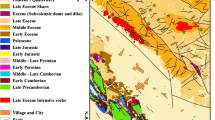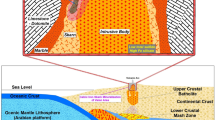Abstract
The capability of a famous multi criteria decision making (MCDM) technique, which is called “the technique for order preference by similarity to ideal solution” (TOPSIS), was considered in this research for better and more precise evaluation porphyry copper-molybdenum deposit in deposit-scale studies. Various evidence layers are usually raster-based maps comprising geological, geochemical, and geophysical which are integrated to supply a mineral prospectivity mapping (MPM). Ten evidence layers with previous boreholes of the Zafarqand copper-molybdenum deposit (located in centeral region of the Urumieh-Dokhtar volcanic arc in Iran) are employed to explore the regions of interest as detailed entirely. TOPSIS can investigate a region of interest more exact than other knowledge-driven integration methods and so can save a lot money in deposit-scale studies due to using numerous alternative points. The final detailed map is produced by TOPSIS technique and the outputs are validated through comparison to field reconnaissance and twenty-four boreholes that have been categorized as three classes. DCCR value was 87.5% that demonstrates high level of statistical confidence. This proposed method established which has a high performance in procuring the final detailed map due to can avoid abortive additional drilling in a study area. In this regard, deposit-scale studies always require a reliable MPM for ultimate evaluations.








Similar content being viewed by others
References
Agterberg FP, Bonham-Carter GF (2005) Measuring the performance of mineral-potential maps. Nat Resour Res 14(1):1–17
An P, Moon W, Rencz A (1991) Integration of geological, geophysical, and remote sensing data using fuzzy set theory. Can J Explor Geophys 27(1):1–11
Ataei M, Sereshki F, Jamshidi M, Jalali S (2008) Suitable mining method for Golbini No. 8 deposit in Jajarm (Iran) using TOPSIS method. Min Technol 117(1):1–5
Bonham-Carter GF (2014) Geographic information systems for geoscientists: modelling with GIS. Elsevier
Carranza EJM (2008) Geochemical anomaly and mineral prospectivity mapping in GIS. Elsevier
Carranza EJM (2009) Controls on mineral deposit occurrence inferred from analysis of their spatial pattern and spatial association with geological features. Ore Geol Rev 35(3–4):383–400
Carranza EJM, Hale M (2002) Where are porphyry copper deposits spatially localized? A case study in Benguet province, Philippines. Nat Resour Res 11(1):45–59
Carranza EJM, Hale M (2003) Evidential belief functions for data-driven geologically constrained mapping of gold potential, Baguio district, Philippines. Ore Geol Rev 22(1–2):117–132
Carranza EJM, Sadeghi M (2010) Predictive mapping of prospectivity and quantitative estimation of undiscovered VMS deposits in Skellefte district (Sweden). Ore Geol Rev 38(3):219–241
Carranza E, Woldai T, Chikambwe E (2005) Application of data-driven evidential belief functions to prospectivity mapping for aquamarine-bearing pegmatites, Lundazi district, Zambia. Nat Resour Res 14(1):47–63
Carranza E, Hale M, Faassen C (2008) Selection of coherent deposit-type locations and their application in data-driven mineral prospectivity mapping. Ore Geol Rev 33(3–4):536–558
Cheng S, Chan CW, Huang GH (2002) Using multiple criteria decision analysis for supporting decisions of solid waste management. J Environ Sci Health, Part A 37(6):975–990
Chung C-JF, Moon WM (1991) Combination rules of spatial geoscience data for mineral exploration. Geoinformatics 2(2):159–169
Dağdeviren M, Yavuz S, Kılınç N (2009) Weapon selection using the AHP and TOPSIS methods under fuzzy environment. Expert Syst Appl 36(4):8143–8151
Ford A, Miller JM, Mol AG (2016) A comparative analysis of weights of evidence, evidential belief functions, and fuzzy logic for mineral potential mapping using incomplete data at the scale of investigation. Nat Resour Res 25(1):19–33
Gabr S, Ghulam A, Kusky T (2010) Detecting areas of high-potential gold mineralization using ASTER data. Ore Geol Rev 38(1):59–69
Lee S, Hwang J, Park I (2013) Application of data-driven evidential belief functions to landslide susceptibility mapping in Jinbu, Korea. CATENA 100:15–30
Mergias I, Moustakas K, Papadopoulos A, Loizidou M (2007) Multi-criteria decision aid approach for the selection of the best compromise management scheme for ELVs: The case of Cyprus. J Hazard Mater 147(3):706–717
Mirzaei M, Afzal P, Adib A, Khalajmasoumi M, Zarifi AZ (2014) Prospection of iron and manganese using index overlay. and fuzzy logic methods in balvard 1: 100,000 sheet, southeastern Iran. Iran J Earth Sci 6:1–11
Moon WM (1990) Integration of geophysical and geological data using evidential belief function. IEEE Trans Geosci Remote Sens 28(4):711–720
Moradi M, Basiri S, Kananian A, Kabiri K (2015) Fuzzy logic modeling for hydrothermal gold mineralization mapping using geochemical, geological, ASTER imageries and other geo-data, a case study in Central Alborz, Iran. Earth Sci Inform 8(1):197–205
Nabighian MN (1972) The analytic signal of two-dimensional magnetic bodies with polygonal cross-section: its properties and use for automated anomaly interpretation. Geophysics 37(3):507–517
Nabighian MN (1974) Additional comments on the analytic signal of two-dimensional magnetic bodies with polygonal cross-section. Geophysics 39(1):85–92
Nabighian MN (1984) Toward a three-dimensional automatic interpretation of potential field data via generalized Hilbert transforms: Fundamental relations. Geophysics 49(6):780–786
Nykänen V, Salmirinne H (2007) Prospectivity analysis of gold using regional geophysical and geochemical data from the Central Lapland Greenstone Belt, Finland. Geological Survey of Finland 44:251–269
Opricovic S, Tzeng G-H (2004) Compromise solution by MCDM methods: a comparative analysis of VIKOR and TOPSIS. Eur J Oper Res 156(2):445–455
Porwal A, Carranza E, Hale M (2004) A hybrid neuro-fuzzy model for mineral potential mapping. Math Geol 36(7):803–826
Sabbaghi H (2018) A combinative technique to recognise and discriminate turquoise stone. Vib Spectrosc 99:93–99
Sabbaghi H, Moradzadeh A (2018) ASTER spectral analysis for host rock associated with porphyry copper-molybdenum mineralization. J Geol Soc India 91(5):627–638
Sabbaghi H, Tabatabaei SH (2020) A combinative knowledge-driven integration method for integrating geophysical layers with geological and geochemical datasets. J Appl Geophys 172:103915
Samimi Namin F, Shahriar K, Ataee-Pour M, Dehghani H (2008) A new model for mining method selection of mineral deposit based on fuzzy decision making. J South Afr Inst Min Metall 108(7):385–395
Singer DA, Kouda R (1996) Application of a feedforward neural network in the search for Kuroko deposits in the Hokuroku district, Japan. Math Geol 28(8):1017–1023
Tavana M, Hatami-Marbini A (2011) A group AHP-TOPSIS framework for human spaceflight mission planning at NASA. Expert Syst Appl 38(11):13588–13603
Yousefi M, Carranza EJM (2015a) Fuzzification of continuous-value spatial evidence for mineral prospectivity mapping. Comput Geosci 74:97–109
Yousefi M, Carranza EJM (2015b) Prediction–area (P–A) plot and C–a fractal analysis to classify and evaluate evidential maps for mineral prospectivity modeling. Comput Geosci 79:69–81
Yousefi M, Carranza EJM (2015c) Geometric average of spatial evidence data layers: a GIS-based multi-criteria decision-making approach to mineral prospectivity mapping. Comput Geosci 83:72–79
Yousefi M, Nykänen V (2016) Data-driven logistic-based weighting of geochemical and geological evidence layers in mineral prospectivity mapping. J Geochem Explor 164:94–106
Agterberg F, Bonham-Carter G (1999) Logistic regression and weights of evidence modeling in mineral exploration, p. 490
Bonham-Carter GF (1989) Weights of evidence modeling: a new approach to mapping mineral potential. Statistical applications in the earth sciences, 171–183
Bonham-Carter, G.F. (1994) Geographic information systems for geoscientists-modeling with GIS. Computer methods in the geoscientists 13, 398
Chen S-J, Hwang C-L (1992) Fuzzy multiple attribute decision making, pp. 289–486, Springer
Elyasi G (2009) Mineral potential mapping in detailed stage using GIS in one of exploration prospects of Kerman Province. Master of Science Thesis, University of Tehran (published in Persian)
Hwang C-L, Yoon K (1981) Multiple attribute decision making, pp. 58–191, Springer
Pan G, Harris DP (2000) Information synthesis for mineral exploration (spatial information systems)
Porwal A, Carranza E, Hale M (2003) Artificial neural networks for mineral-potential mapping: a case study from Aravalli Province, Western India. Nat Resour Res 12(3), 155-171
Acknowledgements
The authors would like to thank the Aflak Geological Survey and Mineral Exploration Company for providing borehole samples and laboratory studies. Many thanks for The Land Processes Distributed Active Archive Center (LPDAAC) at NASA for providing ASTER data and National Iranian Copper Industries Company (NICIC) to assist us in this work.
Author information
Authors and Affiliations
Corresponding author
Ethics declarations
Conflict of interest
The authors declare no competing interests.
Additional information
Responsible editor: Narasimman Sundararajan
Rights and permissions
About this article
Cite this article
Sabbaghi, H., Tabatabaei, S.H. Application of the most competent knowledge-driven integration method for deposit-scale studies. Arab J Geosci 15, 1057 (2022). https://doi.org/10.1007/s12517-022-10217-z
Received:
Accepted:
Published:
DOI: https://doi.org/10.1007/s12517-022-10217-z




